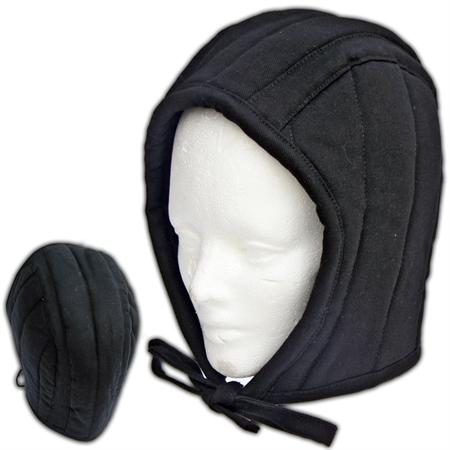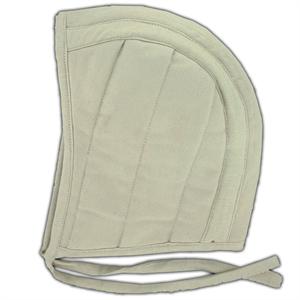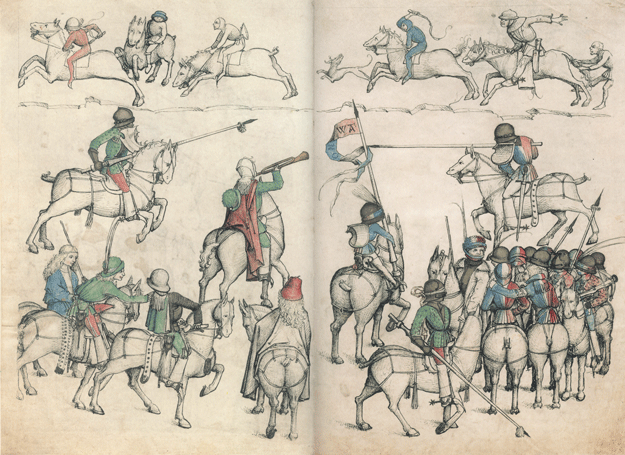| Author |
Message |
|
Mark Griffin
Location: The Welsh Marches, in the hills above Newtown, Powys. Joined: 28 Dec 2006
Posts: 802
|
 Posted: Fri 07 Feb, 2014 1:00 pm Post subject: The 'arming cap' or 'padded coif'. Posted: Fri 07 Feb, 2014 1:00 pm Post subject: The 'arming cap' or 'padded coif'. |
 |
|
My main area for study is the mid 15th to early 16th cents but as things historical is my profession too I cover most periods stone age onwards.
Over the years the market in cheap and dare i say it badly made costume items for the medieval re-enactor has grown and grown to the point that if you make something cheaply enough and its bought by enough people it becomes gospel simply by weight of presence. I'd also say even the good items, if worn by enough people but in the wrong context also take on an air of accuracy but without the provenance to prove it.
I don't want to start a general discussion on this as this site is far more focused than that so I'd like to pick on one item of military clothing (ignoring the civilian ones...) the arming cap or padded coif.
I started studying the Morgan Library King Louis bible to start looking at a typeology for the earlier periods but as I look at a lot of 15th cent re-enactors here in the UK I suddenly thought that I'm not aware of that many images of these garments from the Wars of the Roses or say about 50-75 years before and after.
Admittedly there could be hundreds of them underneath mail and helmet etc etc but by the late 14th cent when the bascinet and then the sallet and armet start to hold sway surely these mostly come with an integral liner? And if the helmet doesn't quite fit, surely they wouldn't quite fit to the extent of needing a heavily padded garment like most of the ones you can get on ebay for a few pennies? There are not many helmets even that show no sign of having a liner or suspender of some sort and of course helmet stuffers and liners were a distinct and separate trade so that reduces the need for them further.
So, could I suggest a hypothesis that the arming cap/coif should really only be seen up to the late 13th cent? I'm ignoring the civilian ones, one or two layers of linen with no filling, plenty of those in Flemish books of hours, the Decameron etc etc and there are just a couple of padded caps ( I differentiate the cap from the coif by not having a tie under the chin) on the odd N European painting from Austria, Bohemia and that general area but none from England, the Low Countries, France etc.
Anyone have any pictorial sources for the padded coif or 'arming cap' from 1350-1525? I mean a seperate, quilted or padded garment to go under a helmet.
And the liners for the jousting helmets in Vienna and elsewhere are not coifs by any stretch of the imagination, they are in a separate class of their own.
Thanks!
Griff
|
|
  |
 |
|
Mart Shearer
|
|
  |
 |
John Farthing

Location: ARMA Middle Tennessee Joined: 16 Jan 2011
Posts: 10
|
 Posted: Fri 07 Feb, 2014 5:01 pm Post subject: Posted: Fri 07 Feb, 2014 5:01 pm Post subject: |
 |
|
This page documents their use in the fifteenth and sixteenth centuries.
http://larsdatter.com/coifs.htm
-John Farthing, Deputy Director (ARMA)
Association for Renaissance Martial Arts
|
|
    |
 |
|
Sean Manning
|
 Posted: Sat 08 Feb, 2014 12:14 am Post subject: Posted: Sat 08 Feb, 2014 12:14 am Post subject: |
 |
|
Citing oneself is bad form, but see the first of three threads on arming garments.
What image of martial gentleman wearing coifs in public are you thinking of? I would be happy to add images which fit those criteria to the arming garments thread.
|
|
  |
 |
|
Mark Griffin
Location: The Welsh Marches, in the hills above Newtown, Powys. Joined: 28 Dec 2006
Posts: 802
|
 Posted: Sat 08 Feb, 2014 11:23 am Post subject: Posted: Sat 08 Feb, 2014 11:23 am Post subject: |
 |
|
| Quote: | | This page documents their use in the fifteenth and sixteenth centuries. |
But not military ones, my focus of research. Ones used for padding, not for keeping your hair neat and tidy and off of bed linen.
I'd class the ones in the Paumgartner panels in this category, they are almost like hairnets. Having lost a particularly hectic harnessed bout when blinded by my own unruly hair (15 years ago, passage of time means I no longer have that problem!) I know they are jolly useful.
|
|
  |
 |
|
Mark Griffin
Location: The Welsh Marches, in the hills above Newtown, Powys. Joined: 28 Dec 2006
Posts: 802
|
 Posted: Sat 08 Feb, 2014 11:36 am Post subject: Posted: Sat 08 Feb, 2014 11:36 am Post subject: |
 |
|
This is what I'm talking about. Ignoring the fact that they are badly tailored and made for questionable materials and methods, its the while concept of such garments in the 15th cent that piques my interest.
There is a preponderance of these things in UK WOTR impressions and I'd love to be able to see evidence of such past the mid 14th.
I sometimes wear a plain coif for the sweat issue but inside a helmet they can slip. That's a pain in a locked up armet on a horse so I pay more attention to the integral liner.
 Attachment: 20.37 KB Attachment: 20.37 KB

 Attachment: 8.92 KB Attachment: 8.92 KB

 Attachment: 24.98 KB Attachment: 24.98 KB
![copy-of-larp-costume-arthur-padded-sleeves-[4]-7137-p.jpg](files/copy_of_larp_costume_arthur_padded_sleeves_4_7137_p_772.jpg)
|
|
  |
 |
|
Mark Griffin
Location: The Welsh Marches, in the hills above Newtown, Powys. Joined: 28 Dec 2006
Posts: 802
|
 Posted: Sat 08 Feb, 2014 11:40 am Post subject: Posted: Sat 08 Feb, 2014 11:40 am Post subject: |
 |
|
although following Steve thread, here is a great pic i wasn't aware of, thanks.
http://gallica.bnf.fr/ark:/12148/btv1b52000996s/f438.item
Its useful although shows the kind of padding thats associated with the bascinet (although the chap in the middle seems to have a coif, rather than a hood) and I'd like to look more at the slightly later sallets etc.
|
|
  |
 |
|
Robert MacPherson
Industry Professional
Location: Jeffersonville USA Joined: 27 Feb 2008
Posts: 141
|
 Posted: Sat 08 Feb, 2014 2:34 pm Post subject: Posted: Sat 08 Feb, 2014 2:34 pm Post subject: |
 |
|
Mark,
The soldiers guarding the Holy Sepulcher are frequently depicted in armor that suggests that they were pretty low on the food chain. I suspect that the padded hoods in that pic are the only headgear that those fellows had. In other words, for better of worse, those are their helmets. The one on the left has a feather coming out of the top or his padded headpiece, just like the feathers on the bascinets of the slightly better equipped guys. This makes it even less likely that he expects to but a helmet on over it.
Mac
Robert MacPherson
http://www.lightlink.com/armory/
http://billyandcharlie.com/
|
|
   |
 |
|
Mark Griffin
Location: The Welsh Marches, in the hills above Newtown, Powys. Joined: 28 Dec 2006
Posts: 802
|
 Posted: Sun 09 Feb, 2014 2:00 am Post subject: Posted: Sun 09 Feb, 2014 2:00 am Post subject: |
 |
|
Hi Mac,
Thanks for that. I know you'll agree that soldiers in this bit of iconography are very often depicted as being a bit archaic, especially the further into the Northern germanic areas you go. Judging by the artwork, the modelling of the drapery etc I'd go with the Mandragore date of not much more than 1404.
The guy in the middle certainly seems to be wearing a cap, no evidence of a hood coming down over his shoulders. But I'm still keen to see any form of padded separate cap from the 15th cent. Any more images gratefully received!
|
|
  |
 |
|
Robert MacPherson
Industry Professional
Location: Jeffersonville USA Joined: 27 Feb 2008
Posts: 141
|
 Posted: Sun 09 Feb, 2014 9:44 am Post subject: Posted: Sun 09 Feb, 2014 9:44 am Post subject: |
 |
|
Mark,
It's true. The guy in the middle does not have a "cape" on his headpiece. Neither does he have a feather sticking out of it. That may make it an arming cap. On the other hand he does not have a helmet lying next to him. But, it's a cluttered composition, and the artist might not have bothered to paint one in for him.
I guess I would file this under "possible padded arming caps". But I would not want to use it as a pivotal piece of evidence in their favor.
In my opinion, the padded arming cap probably goes hand in hand with wearing mail on the head. As soon as the mail becomes part of the helmet and not something that gets put on under it, the padded cap becomes redundant. Now, we see that some guys were apparently wearing mail under kettle hats into the 15th C, while their economic betters were wearing bascinets with aventails; so we are hard pressed to put a cut off date on their use.
Mac
Robert MacPherson
http://www.lightlink.com/armory/
http://billyandcharlie.com/
|
|
   |
 |
|
Henrik Granlid
|
 Posted: Sun 09 Feb, 2014 10:15 am Post subject: Posted: Sun 09 Feb, 2014 10:15 am Post subject: |
 |
|
On the topic of reenacting the period of War of the Roses and what head protection to expect, we know that sallets had a padded suspension-lining, there have been findings of this.
We also know from depictions, statues and needle-holes in relics that Bascinets were padded in their entirety, together with padded aventails.
The padded coif is not needed for pieces such as these, since all of the padding needed can be put into the helmet at this stage. It could well have been possible to use a padded coif in order to improve the fit of one of these helmets, however, there is no practical reason whatsoever to keep a padded coif instead of having a secured, non-sliding helmet liner stuffed to snuggly set the helmet on your head.
On a different note, I know that it is important to protect yourself during reenactment and I doubt few people want broken jaws, but, looking at the head-traumas of the battle of Towton, we see two very specific wounds showing up quite a few times. This was presented on "The Medieval Dead" as executions or happenstance injuries, but I would like to field a different theory.
My notion of the origin of these wounds actually come down to equipment.
The wounds in question are a nick to the bone on the right side of the jaw, and the other presented being the front teeth (with the bone) being sheared off by a bladed instrument, likely from the upper left.
Both of these however, tell me that it might well be due to a standardisation of equipment, namely, Sallets. If a sallet is worn without a bevor, especially the non-visored ones, blows from above would cause injury after passing the sallet, meaning they'd cause primary cuts on the jawbone and, in the case of "high" sallet edges, the upper lip.
This, to me, shows a lot of non-bevored sallets in use, possibly being worn with.
Drumroll.
A mail coif.
And we're back on the first topic.
As I said, there is little to no point in wearing a padded coif together with most any helmet from the late 14th century and onwards, however, as previously stated in the thread, they were in use together with mail coifs (and together with greathelms to help secure them).
This could mean that there are, indeed, reasons for non-bevored warriors to be wearing a padded coif, namely that they use a chainmail coif as well. Kettlehats and Sallets can both be worn with bevors, and it is frequently done by reenactors today, simply because of safety features. Now, as you said yourself, even nice things can get misrepresented and taken as canon, simply because they conform to something such as safety requirements among a reputable troupe of people.
This lands me in the "For anything that isn't using a chainmail coif? You shouldn't use one."
However, I myself cannot be entirely certain when the chainmail coif goes completely out of fashion, and as such, if you wear a coif, I am half expecting you to at least have something very slightly padded (two/three layers of linnen or somesuch) underneath the coif not to have your head turned into mince.
|
|
  |
 |
|
Mart Shearer
|
 Posted: Sun 09 Feb, 2014 12:35 pm Post subject: Posted: Sun 09 Feb, 2014 12:35 pm Post subject: |
 |
|
Perhaps if they had been wearing a mail coif beneath the sallet, the injuries would have been avoided? I confess that I haven't spent a lot of time looking at late 15th century manuscripts, so I wonder how much evidence there is for mail under sallets or kettle hats during the WoTR?

Mac has brought up the issue of the mail bevors in the past. Perhaps they were suspended from some sort of cloth cap, as no one has figured out how to keep them up on the face?
ferrum ferro acuitur et homo exacuit faciem amici sui
|
|
  |
 |
Mark T

|
 Posted: Wed 18 Jun, 2014 4:08 pm Post subject: Posted: Wed 18 Jun, 2014 4:08 pm Post subject: |
 |
|
Hi Griff,
I'm sure you've seen this image before, but for the interests of completeness of the thread, here's the trumpeter from the Sharfrennen image in the Mittelalterliches Hausbuch.
This is shown on someone who has a hat, not a helmet, so it's not proof that they were worn under helmets per se. It also appears to be unpadded, and over a fringed hood, as are shown on others who are wearing helmets - both in the Hausbuch, and in a few of Durer's images.
I remember this image was used by HE and others as a historical source for their coifs. I can't see it on their site now (with a cursory look), but they do make reference to an 'unpadded arming coif' that they offer with 15th C doublets, so if you were wanting to follow up on unpadded coifs, it could be worth asking Gwen about other possible sources.
And, in the interests of completeness, here's almost all there is to know about hairnets / cauls worn under helmets: http://www.myArmoury.com/talk/viewtopic.php?t=23147 .... BTW, I'm in the middle of commissioning a handmade hairnet at the moment ... will try to remember to post in that thread how it goes!
 Attachment: 244.66 KB Attachment: 244.66 KB

 Attachment: 243.52 KB Attachment: 243.52 KB

Chief Librarian/Curator, Isaac Leibowitz Librarmoury
Schallern sind sehr sexy!
|
|
  |
 |
Mark T

|
 Posted: Wed 18 Jun, 2014 4:45 pm Post subject: Posted: Wed 18 Jun, 2014 4:45 pm Post subject: |
 |
|
And for those who are interested, this thread on helmet liners has more images of fringed hoods under helmets: http://www.myArmoury.com/talk/viewtopic.php?t...p;start=20
(That's page 2; page 1 has more on liners.)
Chief Librarian/Curator, Isaac Leibowitz Librarmoury
Schallern sind sehr sexy!
|
|
  |
 |
|
|
You cannot post new topics in this forum
You cannot reply to topics in this forum
You cannot edit your posts in this forum
You cannot delete your posts in this forum
You cannot vote in polls in this forum
You cannot attach files in this forum
You can download files in this forum
|
All contents © Copyright 2003-2025 myArmoury.com — All rights reserved
Discussion forums powered by phpBB © The phpBB Group
Switch to the Basic Low-bandwidth Version of the forum
|

